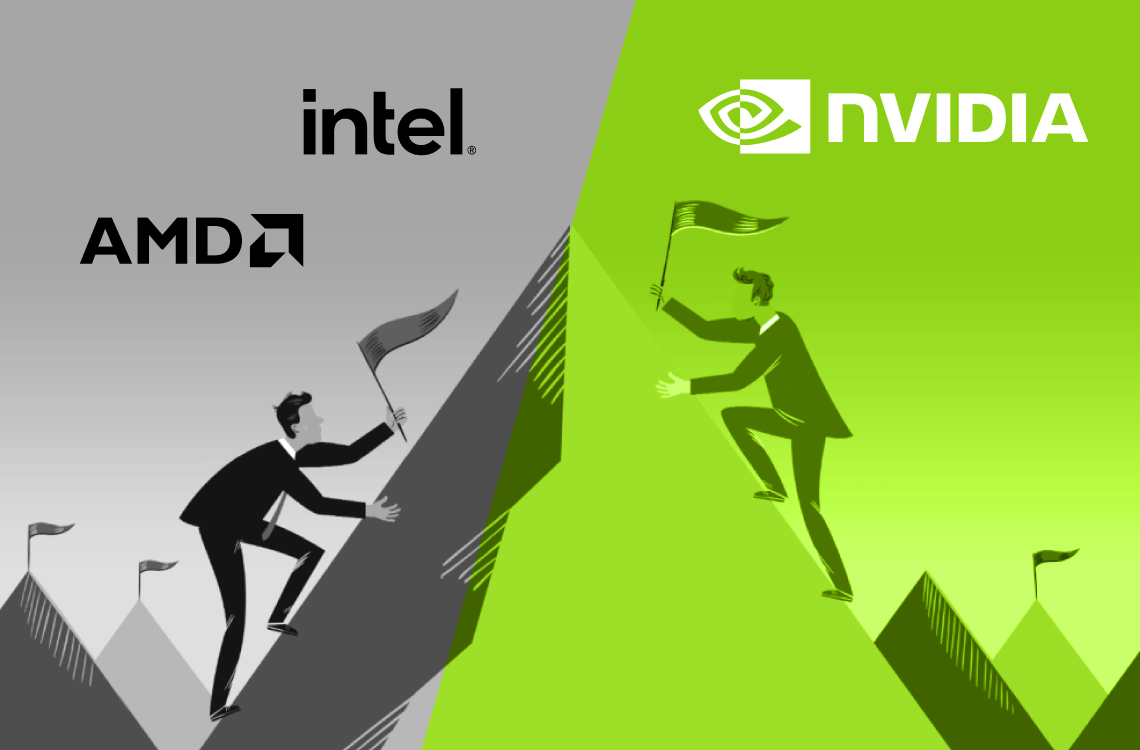NVIDIA is a leading technology company that has revolutionized the field of computer graphics, video games, and artificial intelligence. Founded in 1993 by Jensen Huang, Chris Malachowsky, and Curtis Priem, NVIDIA has been at the forefront of innovation for over two decades. The company’s name is derived from the Latin word “nvidia,” meaning “envy,” which reflects its mission to create products that are so advanced they inspire envy among its competitors.
NVIDIA’s initial focus was on developing high-performance graphics processing units (GPUs) for personal computers. At the time, most graphics cards were slow and struggled to keep up with the demands of 3D gaming. NVIDIA’s first product, the NVIDIA NV1, was released in 1995 and quickly gained popularity among gamers due to its superior performance and ability to handle complex graphics.
In the early 2000s, NVIDIA expanded into the professional visualization market with their Quadro line of GPUs. These powerful graphics cards enabled architects, engineers, and designers to create detailed 3D models and simulations, improving their workflow and productivity.
However, it was NVIDIA’s entry into the world of deep learning and artificial intelligence (AI) that truly cemented their position as a leader in the tech industry. In 2007, NVIDIA introduced the Tesla GPU, designed specifically for machine learning applications. This move proved to be a game-changer, as researchers and scientists could now train AI models much faster than before, leading to breakthroughs in areas such as image recognition, natural language processing, and autonomous vehicles.
Today, NVIDIA offers a wide range of products and services, including consumer-grade GPUs, data center solutions, and cloud computing platforms. Their flagship product, the GeForce RTX series, provides unparalleled performance for PC gaming enthusiasts, while their Tegra processors power some of the world’s most advanced autonomous driving systems. Additionally, NVIDIA’s acquisition of Mellanox Technologies in 2020 further solidified their position in the data center market, enabling them to offer end-to-end solutions for enterprises looking to adopt AI and hyperscale computing.
Despite facing intense competition and regulatory challenges along the way, NVIDIA has consistently demonstrated its commitment to innovation and sustainability. They have established partnerships with top universities and research institutions, investing heavily in AI research and development. Moreover, NVIDIA has made significant strides towards reducing their environmental impact through renewable energy initiatives and sustainable manufacturing practices.
As we look to the future, NVIDIA is poised to continue shaping the technological landscape. With the rise of AI, robotics, and virtual reality, their expertise in GPU architecture and software will play a critical role in creating new opportunities and transforming industries. As always, NVIDIA remains focused on pushing the boundaries of what’s possible, leaving us excited to see what they have in store for us next.
Top Competitors and Alternatives of NVIDIA
NVIDIA Corporation (NVDA) is a semiconductor company that manufactures high-end graphics processing units (GPUs). As of 2023, NVIDIA has about 80% of the global market share in GPU semiconductor chips. Here are some of NVIDIA’s competitors –
1. Intel

Intel is a leading manufacturer of central processing units (CPUs) and other semiconductor products, while NVIDIA specializes in designing and manufacturing graphics processing units (GPUs) and high-performance computing hardware. Both companies are major players in the technology sector, with a significant presence in the market for computer hardware and software.
Here’s a table comparing some key aspects of Intel and NVIDIA:
| Company | Founded | Headquarters | Products | Market Cap | Revenue | Employees |
|---|---|---|---|---|---|---|
| Intel | 1968 | Santa Clara, CA | CPUs, GPUs, FPGAs, SSDs | $183 billion | $54 billion | 124,800 |
| NVIDIA | 1993 | Santa Clara, CA | GPUs, Tegra processors, Quadro graphics cards | $1.79 trillion | $26.79 billion | 26,000 |
Both Intel and NVIDIA have strong research and development programs, and they invest heavily in emerging technologies like artificial intelligence, machine learning, and autonomous driving. They also compete in various markets, including:
- Graphics Processing Units (GPUs): NVIDIA has been the dominant player in this market for years, with its GeForce GPUs being widely used in gaming and professional visualization applications. However, Intel has been gaining ground with its Integrated Visual Processing Unit (IPU), which integrates a custom GPU core into its CPU packages.
- Artificial Intelligence (AI) and Machine Learning (ML): Both companies offer AI and ML solutions, with NVIDIA’s GPUs being popular choices for training deep neural networks. Intel has developed its own AI accelerator, the Nervana Neural Stick, and acquired AI startups like Altera and Movidius to enhance its capabilities.
- Autonomous Driving: NVIDIA’s Drive platform is a leader in the autonomous driving space, providing AI-powered solutions for vehicle perception, mapping, and control. Intel has invested in Mobileye, an Israeli company that develops vision-based advanced driver assistance systems (ADAS).
- Datacenter Business: Intel dominates the server processor market, but NVIDIA’s datacenter revenue has grown rapidly due to demand for its GPUs in cloud computing, big data analytics, and scientific simulations.
- High-Performance Computing (HPC): Both companies offer HPC solutions, with Intel’s Xeon Phi processors and NVIDIA’s Tesla V100 GPUs being popular choices for supercomputing applications.
In summary, Intel and NVIDIA are fierce competitors across several areas in the technology industry, from GPUs and AI acceleration to autonomous driving and datacenters. While Intel has a broader product portfolio and larger market share in some segments, NVIDIA’s focus on GPUs and AI has allowed it to maintain a strong position in those markets.
2. Advanced Micro Devices (AMD)
Advanced Micro Devices (AMD) is a major competitor of NVIDIA in the graphics processing unit (GPU) market. AMD’s GPUs, known as Radeons, compete directly with NVIDIA’s GeForce GPUs in the consumer and professional markets. AMD also produces APUs (accelerated processing units), which integrate a CPU and GPU onto a single chip, competing with NVIDIA’s Tegra processors.
One of AMD’s strengths is its focus on power efficiency, which makes its GPUs appealing to consumers who prioritize low power consumption and heat generation. Additionally, AMD’s GPUs are generally less expensive than NVIDIA’s, making them an attractive option for budget-conscious buyers. AMD has also made strides in the professional market, where its GPUs are used in fields such as engineering, science, and finance.
However, NVIDIA still holds a significant lead in terms of market share and brand recognition. NVIDIA’s GPUs are considered top-of-the-line for gaming and professional use cases, and the company has a strong reputation for delivering cutting-edge technology. Moreover, NVIDIA’s extensive software support and developer ecosystem make it easier for developers to optimize their games and applications for NVIDIA hardware.
Despite these challenges, AMD continues to innovate and push the boundaries of what is possible with GPU technology. The company has announced plans to release new GPU architectures and products in the coming years, which could help it close the gap with NVIDIA. Additionally, AMD’s acquisition of ATI Technologies in 2006 has given it access to valuable intellectual property and expertise in the field of GPU design.
| Company | Founded | Headquarters | Market Share | Revenue (2023) | Employees |
|---|---|---|---|---|---|
| AMD | 1969 | Sunnyvale, CA | 20% – 30% | $23 billion | 26,000 |
| NVIDIA | 1993 | Santa Clara, CA | 70% – 80% | $26.79 billion | 26,000 |
Note: The market share figures are approximate and may vary depending on the source and time frame considered.
3. Qualcomm
Qualcomm is a major competitor of NVIDIA in the field of mobile computing and artificial intelligence (AI). While NVIDIA is known for its graphics processing units (GPUs) and high-performance computing solutions, Qualcomm focuses on developing system-on-chips (SoCs) that integrate multiple functions, including CPUs, GPUs, and modems, onto a single chip. This integration enables Qualcomm’s chips to provide high levels of performance and power efficiency, making them well-suited for mobile devices such as smartphones and tablets.
Qualcomm’s SoCs, such as the Snapdragon series, compete directly with NVIDIA’s Tegra processors in the mobile market. The Snapdragon chips are designed to provide high levels of performance for tasks such as gaming, video streaming, and AI processing, while also offering long battery life and fast charging capabilities. Additionally, Qualcomm’s chips are integrated into a wide range of devices, including Android smartphones and Windows PCs, giving the company a broad reach in the mobile market.
In addition to its SoCs, Qualcomm is also a major player in the field of wireless communications, producing Wi-Fi, Bluetooth, and cellular modem chips. This diversification allows Qualcomm to offer comprehensive connectivity solutions for mobile devices, further differentiating itself from NVIDIA, which primarily focuses on computing and graphics processing.
Despite Qualcomm’s strengths, NVIDIA still holds a significant lead in the high-performance computing market, particularly in the fields of computer vision, natural language processing, and deep learning. NVIDIA’s GPUs are widely adopted in data centers and supercomputing environments, and the company’s CUDA programming platform is widely used by developers working on AI and machine learning applications. However, Qualcomm is actively expanding its AI capabilities through initiatives such as its acquisition of Cruise Automation and its partnership with Google to develop AI-enabled edge devices.
| Company | Founded | Headquarters | Market Share | Revenue | Employees |
|---|---|---|---|---|---|
| Qualcomm | 1985 | San Diego, CA | 60% – 70% | $35.8 billion | 50,000 |
| NVIDIA | 1993 | Santa Clara, CA | 30% – 40% | $26.79 billion | 26,000 |
Note: The market share figures are approximate and may vary depending on the source and time frame considered.
4. IBM
IBM is a competitor of NVIDIA in the field of artificial intelligence (AI) and high-performance computing. While NVIDIA is known for its graphics processing units (GPUs) and high-performance computing solutions, IBM focuses on developing cognitive computing solutions that leverage its Watson AI platform. IBM’s Watson platform uses machine learning, natural language processing, and other AI techniques to analyze large amounts of data and provide insights and recommendations to businesses and organizations.
IBM’s Watson platform competes directly with NVIDIA’s AI solutions, such as its Deep Learning SDK and TensorRT software. Both companies offer tools and services that enable developers to build and deploy AI models, but IBM’s approach emphasizes the use of cognitive computing and machine learning to solve complex business problems. Additionally, IBM’s Watson platform is built on top of the OpenPower architecture, which allows it to take advantage of the open-source community’s contributions and advancements in AI.
In terms of hardware, IBM offers a range of high-performance computing solutions, including its Power Systems and zSeries mainframes. These systems are designed to handle large workloads and provide fast processing times, making them suitable for applications such as financial modeling, weather forecasting, and genome analysis. While NVIDIA’s GPUs are not specifically designed for these types of workloads, IBM’s hardware solutions are optimized for compute-intensive tasks and can be used in conjunction with its Watson AI platform.
Overall, IBM presents a strong challenge to NVIDIA in the AI and high-performance computing markets. Its Watson platform offers a unique approach to AI that emphasizes cognitive computing and machine learning, and its hardware solutions are optimized for compute-intensive tasks. While NVIDIA remains a leader in the GPU market, IBM’s diverse portfolio of AI and computing solutions poses a significant threat to the company’s market share.
| Company | Founded | Headquarters | Market Share | Revenue | Employees |
|---|---|---|---|---|---|
| IBM | 1911 | Armonk, NY | 20% – 30% | $61.1 billion | 288,000 |
| NVIDIA | 1993 | Santa Clara, CA | 70% – 80% | $26.8 billion | 26,000 |
Note: The market share figures are approximate and may vary depending on the source and time frame considered.
5. Alibaba
Alibaba Group Holding Limited is a Chinese multinational conglomerate that specializes in e-commerce, retail, Internet, and technology. While Alibaba is primarily known for its e-commerce platforms, such as Taobao and Tmall, the company has also been expanding its reach into the technology sector, including the field of artificial intelligence (AI). Alibaba’s AI ambitions pose a potential threat to NVIDIA Corporation, a leading provider of graphics processing units (GPUs) and high-performance computing solutions.
Alibaba’s entry into the AI market began with the establishment of its AI research division, Alibaba AI Labs, in 2017. Since then, the company has made significant investments in AI talent recruitment and research and development (R&D). Alibaba AI Labs has developed various AI technologies, including natural language processing (NLP), image recognition, and machine learning algorithms, which are used in various applications, such as customer service chatbots, fraud detection, and recommendation engines.
Alibaba’s AI capabilities have been integrated into its e-commerce platforms, enhancing user experience and improving operational efficiency. For instance, Alibaba’s chatbot, named “Tmall Genie,” uses NLP to assist customers with shopping queries and orders. Additionally, Alibaba’s AI-powered logistics and supply chain management systems have helped streamline delivery processes and reduce costs. Alibaba’s expansion into the AI market poses a threat to NVIDIA’s dominance in the sector, as Alibaba’s AI solutions could potentially replace NVIDIA’s GPUs and high-performance computing solutions in certain applications.
In response to Alibaba’s growing influence in the AI market, NVIDIA has taken steps to bolster its position. NVIDIA has expanded its partnership with Baidu, China’s largest search engine provider, to develop autonomous driving and AI technologies. NVIDIA has also established partnerships with other Chinese tech giants, such as Tencent and JD.com, to enhance its presence in the region. Furthermore, NVIDIA has continued to invest in R&D, unveiling new products and services, such as its TensorRT software and Clara AI platform, to maintain its competitive edge in the AI market.
| Company | Founded | Headquarters | Market Share | Revenue | Employees |
|---|---|---|---|---|---|
| Alibaba | 1999 | Hangzhou, China | 30% – 40% | $129 billion | 228,765 |
| NVIDIA | 1993 | Santa Clara, CA | 70% – 80% | $26 billion | 26,000 |
Note: The market share figures are approximate and may vary depending on the source and time frame considered.
6. Juniper Networks
Juniper Networks is a company that specializes in networking equipment and solutions. They are a major competitor of NVIDIA in the field of network infrastructure, particularly in the area of switches and routers. While NVIDIA is known for its graphics processing units (GPUs) and high-performance computing solutions, Juniper Networks focuses on developing and manufacturing network hardware and software that enable high-speed, secure, and efficient communication networks.
Juniper Networks’ product portfolio includes core routers, edge routers, switches, and security appliances. Their flagship product, the Junos operating system, is a highly scalable and modular network operating system that powers many of the world’s largest service provider and enterprise networks. In addition, Juniper Networks offers a range of software-defined networking (SDN) and network function virtualization (NFV) solutions that enable network administrators to automate and manage their networks more effectively.
In comparison to NVIDIA, Juniper Networks has a smaller market share in the overall technology industry. However, they have a strong presence in the network infrastructure market, where they compete directly with NVIDIA’s networking division, NVIDIA Networking. While NVIDIA Networking focuses on providing high-performance networking solutions for data centers and cloud environments, Juniper Networks offers a broader range of networking products and solutions that cater to a wider range of customers, including service providers, enterprises, and government agencies.
Overall, Juniper Networks poses a significant threat to NVIDIA in the network infrastructure market due to their strong product portfolio, extensive customer base, and expertise in network technology. To remain competitive, NVIDIA will need to continue innovating and expanding its networking solutions to meet the evolving needs of the industry.
| Company | Founded | Headquarters | Market Share | Revenue | Employees |
|---|---|---|---|---|---|
| Juniper Networks | 1996 | Sunnyvale, CA | 20% – 30% | $5.5 billion | 11,000 |
| NVIDIA | 1993 | Santa Clara, CA | 70% – 80% | $26.7 billion | 26,000 |
Note: The market share figures are approximate and may vary depending on the source and time frame considered.
Also Read: Exploring Top Broadcom Competitors in the World
To read more content like this, subscribe to our newsletter
Go to the full page to view and submit the form.


